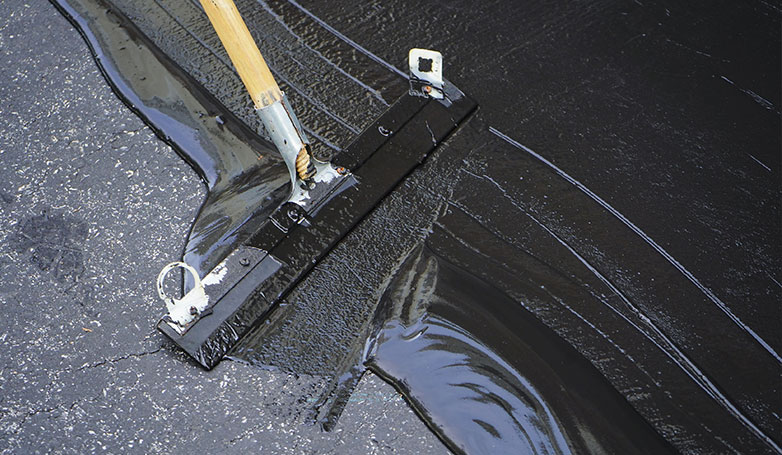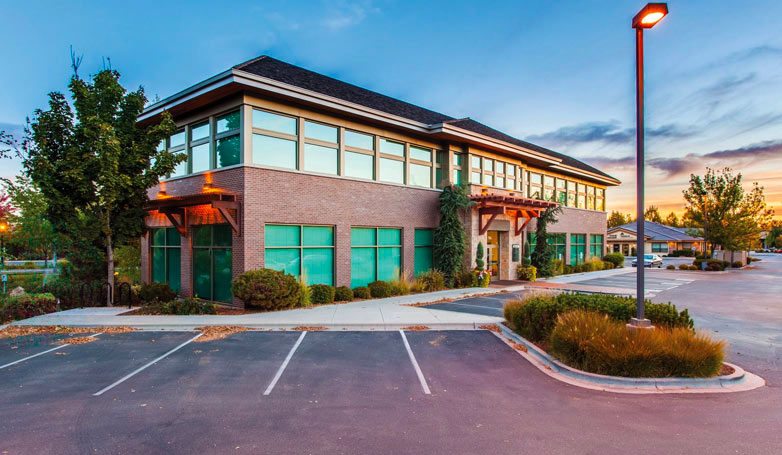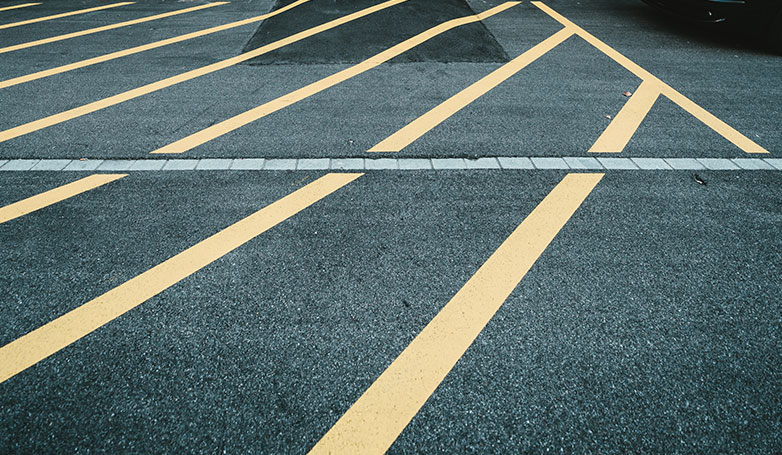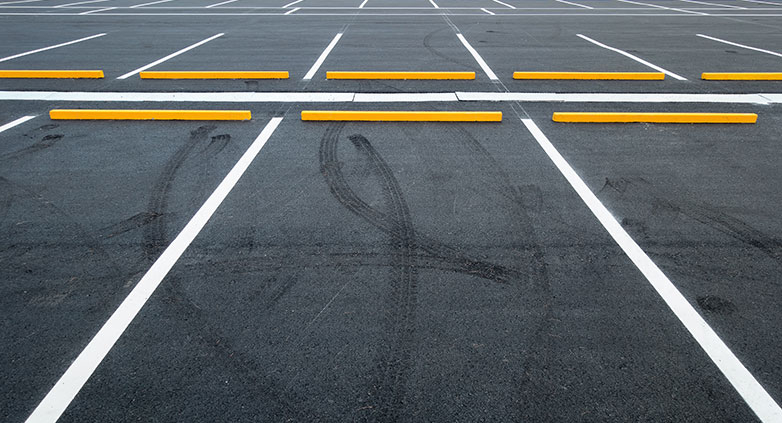Parking Lot Repair – The Importance of Proper Maintenance
If you own a commercial parking lot, even if you’re not there every day, that lot is your responsibility. Should a car blow out a tire or the wheel cracks because a customer drove over a pothole in your parking lot, the liability falls on you. You must maintain and repair your parking lot when necessary to promote its longevity. What should you do?
The following parking lot maintenance tasks will reduce your rate of repairs:
- Cleaning the lot
- Repainting faded stripes and other markings
- Overlaying the asphalt
- Sealing the lot
- Repairing when damage occurs
In this extensive guide, we’ll provide further information on maintaining your parking lot so it remains in its best condition for a long time to come. We’ll also delve into areas of parking lot repair, including how much money you might expect to pay for various repair jobs.

How to Properly Maintain Your Parking Lot
Most parking lots are made of asphalt or concrete. Asphalt, as we covered in this article, is prone to plenty of damage. Here’s a list for you:
- Bleeding, when the asphalt develops a film that can make it slippery if it gets wet, posing significant risks to motorists who use your parking lot
- Raveling, which is when the asphalt fragments, leaving gravel behind
- Upheaval, or the movement of the asphalt upward due to moisture or freezing
- Rutting, which is asphalt depressions from ignoring the parking lot’s max recommended weight
- Potholes, which start as holes in the asphalt that grow bigger and deeper over time
- Cracks, including slippage cracks, joint reflection cracks, edge cracks, block cracks, and alligator cracks
No parking lot is impervious to damage, but through maintenance, mitigation becomes possible. Per the information in the intro, here are the areas of parking lot maintenance to focus on.
Keep the Parking Lot Clean
We’ve discussed this on the blog before, but it’s worth repeating now. Cleaning your parking lot may sound like a basic and thus skippable part of parking lot maintenance, but it’s one of the most important jobs.
Why is that? For several reasons, really. From an aesthetics standpoint, a clean, tidy parking lot will always attract more business than one that’s dirty and looks run-down. Much more importantly, cleaning your parking lot removes small objects that can lead to motorist injuries, which again become a liability for you.
A clean parking lot is one in which the asphalt remains in better condition, as nothing is grinding against it when motorists drive across the lot. You may even be able to enjoy a few more years out of your parking lot.

Repaint Faded Stripes and Lines
Painting the parking lines and other indicators throughout your parking lot wasn’t a cheap nor inexpensive process, but it’s something you’ll have to do much sooner than later. You might get only a year out of the paint before it needs touching up depending on the frequency of parking lot use. In other cases, it’s two years, but no more than that.
You absolutely cannot forego repainting these stripes, lines, and markings. If the lines are faded to the point where they’re barely visible, your customers won’t be able to tell where one parking spot ends and the other begins. This creates an environment where unnecessary car accidents can occur.
Overlay the Asphalt
Although it does nothing for the bottommost layer of asphalt, overlaying the top layer can improve the overall appearance of your parking lot. Further, you might stretch out the longevity of your lot, so overlaying is certainly a job worth doing.
When you overlay asphalt, you pour a fresh layer over the preexisting top layer. That layer still remains intact, as removal would be more labor-intensive and expensive. You end up with asphalt that’s even more multi-layered than before.
Seal the Lot
The last maintenance job to commit to as parking lot owner is sealing the asphalt. Depending on the age of your lot, you may have to reseal it annually or you can possibly go three years before applying some fresh seal. The latter is true of new parking lots and the former of older ones with worn asphalt.

The Most Common Parking Lot Repairs
If you skipped out on some of the above maintenance jobs due to a tight budget, lack of time, or simply inexperience owning and managing a parking lot, then your lot is probably in disarray. Here are some of the more common parking lot repairs you might encounter.
Repairing Cracks
We listed a variety of cracks earlier that tend to affect asphalt. Here’s a quick explanation of the ones that are especially prevalent in parking lots:
- Slippage cracks: Developing in distinct half-crescents, slippage cracks tend to appear shortly after your new parking lot is paved. If the asphalt layers have incorrectly adhered, these cracks will result.
- Joint reflection cracks: We’ll discuss repairing joints shortly, but for now, know that joint cracks occur when the joints are strained through the asphalt subbase. The subbase may move as moisture and temperature changes occur.
- Edge cracks: Common in driveways, roads, and parking lots, edge cracks affect the edge of a street or lot that has insufficient drainage. The moisture accumulation leads to the cracks, as can improperly installed subbase or heavy vehicular traffic.
- Block cracks: When the temperatures get very cold or extremely hot and the asphalt’s binder can’t contract and expand to accommodate, block cracks happen. Why are they called block cracks? Well, due to how these cracks are often rectangular.
- Alligator cracks: Fatigue or alligator cracks look like alligator skin, which is the last thing you want for your parking lot. Many issues can cause alligator cracks, among them too much clay in the surrounding soil, ground movement and erosion, thin pavement, poor subgrade quality, and exceeding your parking lot’s weight limits.
Whether it’s an alligator crack, a slippage crack, or anything in between, repairing a crack should be at the top of your priority list as a parking lot owner. Even small cracks can become bigger as your lot gets a lot of use. Large cracks develop into potholes.
Repairing Potholes
Speaking of potholes, they’re another frequent problem across asphalt roads and parking lots. According to Harper’s Magazine data, as of 2012, the United States has 55,961,000 potholes. Given the age of that data, we’re sure you can add several thousand–if not more–potholes to that tally by now.
Edmonton, Alberta, Canada calls itself “the pothole capital” because its problem with potholes is that serious. In 2014, the city spent $4.8 million to repair potholes, says Canadian news source The Walrus. The city alone adds about 450,000 potholes to its preexisting total every year.
We talked in the intro about how risky leaving potholes intact can be, so repair must be imminent.
Improving Joints
In a perfect world, you’d have gotten your parking lot constructed with high-quality joints. That can prevent a lot of headaches now and in the years to come. After all, the worse the quality of the joints, the fewer years you can expect out of them.
Sealing may be able to restore the strength of the joints provided they haven’t been under much strain for long. Pretending the issue doesn’t exist though can quickly degrade the quality of your parking lot. Alligator cracks might develop, allowing for structural issues that can become full-on lot failure if left unaddressed. Potholes will also appear.
Adding Drainage
Given that so many asphalt problems that impact your parking lot’s structural integrity are related to moisture and other sources of water, having any drainage at all is better than none. Drainage vents or pipes give the water somewhere to travel so it doesn’t linger on the asphalt.

How Much Does It Cost to Repair Your Parking Lot?
Now that you know the duties that lay ahead of you, it’s time to start budgeting for parking lot repairs. To help you do that, you need to know the costs of each job.
According to ProMatcher, a resource for connecting with professionals, sealing asphalt costs an average of $0.22 a square foot for commercial parking lots. On the lower end, you might pay $0.14 per square foot and, on the high end, up to $0.29 per square foot depending on the sealant you choose.
Paving asphalt is $2.81 a square foot on average. The job may be less expensive at $2.24, or it could be costlier, up to $3.37 per square foot.
Paving an asphalt parking lot if you’re adding a two-inch overlay is an average of $1.60 a square foot. Costs may be between $1.40 and $1.70 per square foot depending on the breadth of work, notes ProMatcher.
Here are some maintenance costs to get you started. To sweep and clean your parking lot, expect the job to cost:
- $73.75 if you have a 200-space parking lot
- $83.32 if you have a 500-space parking lot
- $149.17 if you have a 1,000-space parking lot
The costs for repainting your parking lot stripes depends on the size of the stripes and the type of markings you’re adding. For a white stripe that’s four inches, per linear foot, you’d pay $0.34. For 18 feet of striping, that’s $4.27. Handicap parking spots cost about $28.08 each and arrows $18.09 apiece.

How Long Should an Asphalt Parking Lot Last?
By putting all this time, effort, and expense into your parking lot, how many years should you expect to get out of it? At least five to seven years, but well-maintained parking lots may last around 10 or 15 years. If you go above and beyond to ensure your parking lot is always in tip-top shape, the lot could be usable for 20, even 30 years.
Other Ways to Extend the Life of Your Parking Lot Outside of Maintenance
As we’ve established, there’s no better way to enjoy more years out of your parking lot than through maintenance, but that’s not the only way. To wrap up, here are some things you can do in addition to your maintenance routine for a better parking lot.
Don’t Let Small Problems Fester
It’s a lot cheaper–not to mention less laborious–to pave a small hole or crack in the parking lot. You might even be able to patch that area rather than overlay or reseal the whole lot.
If you don’t already, you should visit your parking lot at least weekly when it’s completely empty. Inspect the whole lot, including the edges and corners. These areas are often overlooked but can be the most troublesome.
Should you spot any concerning issues, make a plan for how they’ll get repaired and when. If you’re not the one personally doing repairs, then come back a few days later, following through to ensure the work was done, and adequately at that.

Add More Drainage If You Have Too Much Standing Water
The drainage you have now might not be all that you use for the entire life of your parking lot. If your drainage solution leaves too much standing water, then you may need more drainage or another means of removing the water altogether.
Clean Spills
Besides loose gravel, sticks, rocks, and other debris that inevitably accumulates in and around your parking lot, you also want to remove spills as soon as you notice them. Depending on the fluid that was spilled, it can degrade the quality of your sealant. Now that area may start cracking, which can soon spread to other sections of your parking lot.
Conclusion
To avoid lawsuits and hold onto your customers, maintaining your commercial parking lot is not optional. With the tips and advice we presented to you in this article, you know which issues to be on the lookout for so you can work preventatively to keep your parking lot safe for anyone to use.

